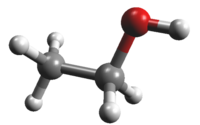|
The anti conformer of ethanol is lower
in energy than the symmetric and antisymmetric
combinations of the gauche conformer
by 39.49 and 42.77 cm–1,
respectively, as determined for the main
isotopolog by
(1) J. C. Pearson, C. S. Brauer, and B. J. Drouin,
2008, J. Mol. Spectrosc. 251, 394.
These conformers are caused by the large amplitude
motion of the OH-group. Internal rotation of the
methyl group has been resolved in part in the
laboratory. The splittings are small enough
to be negligible for observations of hot cores.
Even though there is extensive internal rotation
interaction between the anti and the
gauche conformers, the energy differences
permit these interactions to be neglected for
transitions with low quantum numbers;
in practice, for transitions with
J + 2Ka
≤ 32. The analysis was restricted to such
transitions because these are the ones most likely
to be observed by radioastronomical means.
The data have been summarized by
(2) A. Bouchez, A. Walters, H. S. P. Müller,
M. Ordu, F. Lewen, M. Koerber, S. Bottinelli,
C. P. Endres, and S. Schlemmer,
2012, J. Quant. Spectrosc. Radiat. Transfer
113, 1148.
Additional micowave frequencies have been reported
by
(3) J. P. Culot,
1969, Ann. Soc. Sci. Bruxelles 83, 65.
These transitions have not been merged.
Predictions with J + 2Ka
> 32 should be viewed with caution.
The predictions have been truncated at
J = 40.
Note:
The partition function does not take into account
the gauche-conformers. Therefore,
scaled partition function values are available.
The scaling factors were taken from the main
isotopolog and refer to the ground vibrational
state (anti plus gauche conformers
versus only the anti conformer). The correction
should be quite good. The first excited methyl and OH
torsional modes are both about 250 cm–1
above ground for the main isotolog, and this value
should differ only slightly for 13C
containing species.
The dipole moment was assumed to agree with
that of the main species. This assumption
should be very good for the large b
dipole moment component, but may be very different
for the almost vanishing a dipole
moment component. The values were taken
from
(4) M. Takano, Y. Sasada, and T. Satoh,
1968, J. Mol. Spectrosc. 26, 157.
|
